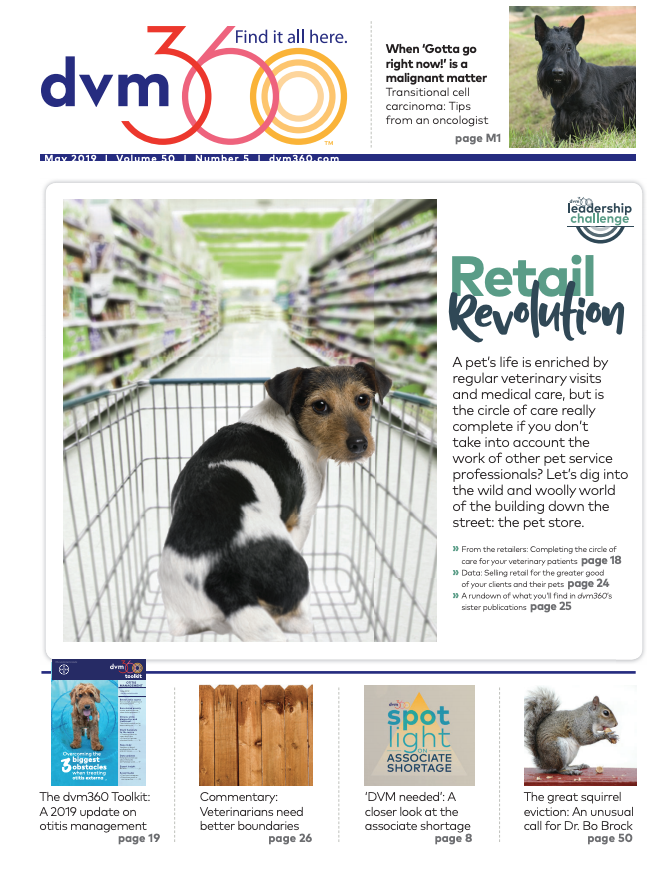Will New York law change veterinary malpractice?
If this state law goes through, malpractice insurance for anyone caring for animals, including veterinary hospitals, could increase. Heres how it could happen as well as a look at a compromise that might hold off the drastic change.
Many would say that the legal definition of animals as property is realistic and practical. Others might opine that viewing companion animals as mere property is anachronistic and out of touch. (adiruch na chiangmai / stock.adobe.com)

Where do sad and angry pet owners, attorneys' paychecks, state legislatures and your veterinary malpractice insurance all come together? Torts. A “tort” is basically your right to sue another person for something unjust he or she did to you. Torts are the reason you have malpractice coverage: If you negligently harm an animal, the owner has the right to sue you and collect money in compensation for your negligent wrongdoing.
Dentists and obstetricians have malpractice policies too-to indemnify them in case they're successfully sued for committing a negligent tort. But they pay a heap more dollars for their policies every year, even though the tort coverage is for the same basic categories of loss: injury and death. So, what part of the tort of negligent practice distinguishes them from us, making their insurance much, much more costly?
In the vast majority of jurisdictions across America, damages for negligent torts resulting in animal injury or death are limited to the economic value of the animal. For example, an 11-year old mixed-breed Yorkie maybe has a market value of a hundred bucks. The best dairy bull in Wisconsin-many thousands of dollars. That's just how malpractice damages are measured in animal cases: “It's not personal, Your Honor, it's just business … ”
How New York could change everything
The “economic value” of the typical companion animal is fairly low. It's not that we don't love them, it's just that the law of torts has traditionally established the recoverable value of a pet or other animal as what that animal is worth as property.
Now, there's a new, expanded tort in a bill winding its way through the New York State Assembly (as well as a companion version being marked up in the Senate). Assembly Bill A1113 adds a new class of recoverable damages for situations where negligence results in injury or death of a companion animal. Here is the heart of the language:
“ … a person who ... recklessly or negligently, by act or omission causes physical injury ... to a companion animal shall be liable in damages for expenses of veterinary and other special medical care required; [and] the loss of reasonably expected society, companionship, comfort, protection and services of the injured companion animal to his or her owner.” [Emphasis mine]
Essentially, this bill proposes that in the event that a companion animal is injured through the negligence of a person, that person may be sued not only for the marketplace value of that animal, but also noneconomic suffering and loss of the animal's owner. In other words, the law creates a new tort cause of action: emotional pain and suffering on the part of an animal's owner.
Proponents and detractors of the new proposed legislation agree on one fundamental point: The landscape of tort law in New York or any other jurisdiction that adopts such a law will instantaneously be changed forever. The reason is twofold.
Reason 1. Higher damages bounce cases to higher courts
Many courts of general jurisdiction (where folks ordinarily sue one another) have a minimum dollar amount below which the parties are forced to take their dispute to a small claims venue. This helps avoid an overcrowded trial docket for judges. In most places, courts are already overflowing with high-dollar civil litigation (and criminal cases that constitutionally must receive “speedy disposition”).
And if a pet owner believes the loss of a pet has caused depression, perhaps visits to obtain therapy, then a claim might easily reach some multiple of $100,000.
However, while the dollar value of a pet isn't easy to estimate, the emotional loss to a pet owner is even harder to objectively calculate. And if a pet owner sincerely believes that the loss of that pet has caused a bout of depression, prolonged sadness-perhaps visits to obtain therapy-then a claim might easily reach some multiple of $100,000-which would place the case squarely in the jurisdiction of a higher, busier court. And that leads us to the next reason...
Reason 2. Higher damages attract plaintiffs' lawyers
As of now, it can be quite difficult for a pet-loss plaintiff to obtain affordable legal representation to pursue a case against a veterinarian, groomer, trainer or other party alleged to have injured or killed a companion animal. Attorneys are often looking for injury cases that involve damages sufficiently high that their contingency fee of one-quarter or one-third of the verdict (or settlement) will justify the time involved in preparing the case.
When the maximum tort award for an animal is based on economic damages, taking on such a case isn't that lucrative. But if noneconomic damages can be awarded (remember, that's “reasonably expected society, companionship, comfort, protection and services” in the New York law), injured pets may become a new profit center for the billboard and late-night TV infomercial law firms.
Result? Higher malpractice premiums
Noneconomic damages are paid by someone. Most of the time, it won't be the boarding facility, the groomer, the trainer or the veterinarian who actually shells out the funds for any successful tort claim. That's why we all have (at least should have) insurance against our own potential negligence.
But remember that today's low premiums are calculated based on the “pets as property” laws in place for decades. In a new world where the number of tort claims for animal injuries skyrockets and the awards in those cases are much greater, the insurance industry will charge more in premiums.
A possible compromise
There's no question that reasonable minds may differ on the necessity and/or appropriateness of a legislative proposal such as A1113. [The full language may be found on the web right here or searching online for “A1113 New York.”]
Many would say that the legal definition of animals as property (particularly companion animals) is realistic and practical. Others might opine that viewing companion animals as mere property is anachronistic and out of touch-that today's pets are viewed by society as far more than objects and that their value to people cannot realistically be measured by what they might bring in cash at a sale.
Both views have some merit, and champions of neither position will be reticent in sharing their thoughts on the subject. Nonetheless, there might be a few areas of compromise that could be introduced into legislation like this that would make it more palatable and easier to pass.
Here are a few practical considerations for compromise:
- In cases where injury to a pet is nonfatal, a requirement that the case be sent to binding arbitration, not court
- A damage ceiling to prevent one-off outlandish jury awards that can and have occurred in human medical malpractice cases
- Reduced permitted attorney contingency fees to 15 or 20 percent
- Required professional psychiatric testimony in cases to support a claim of emotional injury.
The fate of this legislation in New York-as well as similar proposals being considered in a number of other states across the country-will have a long-term impact on our profession. I encourage you to be part of the dialogue and contact your own state legislators to get more information as to the status of comparable proposals in their legislatures.
Dr. Christopher J. Allen is president of the Associates in Veterinary Law PC, which provides legal and consulting services exclusively for veterinarians. He can be reached via email at info@veterinarylaw.com.
